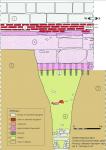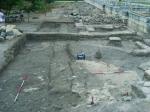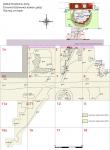Summary (English)
PLISKA (Pavel Georgiev – pavel_g@gbg.bg, Gergana Ilieva, Tihomir Tihov) The explorations continued in the southern aisle of the Great Basilica, to the south of the well – holy spring, in Sondage No. 21 of 1971 where two pits with sherds of the 8th – 9th centuries AD had been discovered. A trench up to 3.95 m deep was explored, with a water-conduit built of uneven stones and slabs on its bottom. The trench with the water-conduit reached the well – holy spring to the north. A layer was discovered under the pavement to the south of the aisle, containing finds of the 9th – beginning of the 10th centuries AD; a layer with fragmentary mortar was situated beneath, spread around the basilica in order to isolate its foundations and to level the terrain. The trench with the water-conduit was also documented in the southern churchyard of the Archbishopric, reaching the surrounding wall and continuing further south. The water-conduit connected the well – holy spring to a spring not located so far. The water-conduit was constructed after the proto-Bulgarian pagan cross-like temple was reconstructed and converted into a church with four conchs, or after the building was completely dismantled, but before the foundations of the Great Basilica were laid. Its construction was related to the resumed or the enhanced functions of the well – holy spring shortly before or after AD 865 when the Bulgars were converted to Christianity. A shallow pit was documented in the churchyard close to the pavement, containing animal bones, sherds, many of them with incised proto-Bulgarian symbol: |Y|, a bone awl. Two Christian graves were discovered: the first one contained the body of a woman with bones of a baby close to her head and the second one belonged to a man; both were laid in wooden coffins. The graves belonged to the cemetery that appeared after the buildings in the southern churchyard of the Archbishopric were destroyed at the end of the 10th – beginning of the 11th century AD. A lime kiln c. 3 m in diameter was explored, dated to the end of the 10th – beginning of the 11th century AD.
- Pavel Georgiev - Shumen Branch of the Archaeological Institute and Museum
- Gergana Ilieva - Regional Museum of History – Shumen
- Tihomir Tihov - Regional Museum of History – Shumen
Director
Team
Research Body
- Regional Museum of History – Shumen
- Shumen Branch of the Archaeological Institute and Museum






![Download [PDF]](/excavation/skins/fasti/images/results/download_sml.png)

